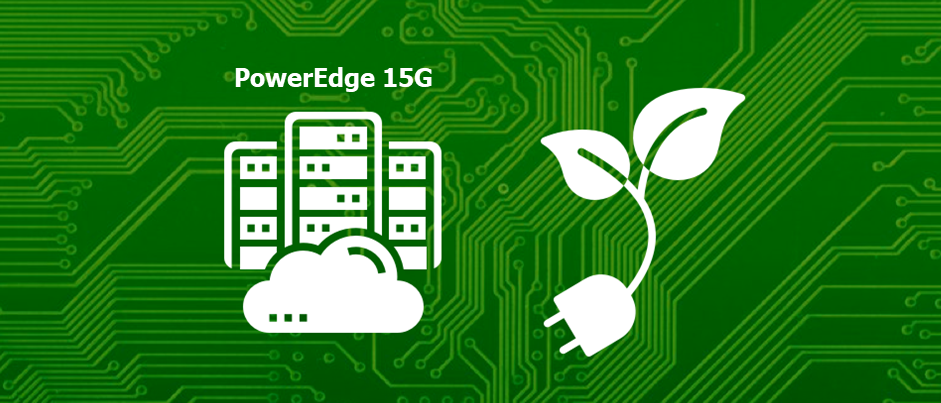Sustainable Infrastructure Part 2: PowerEdge 15G Innovations
- Nomuka Luehr

- Nov 30, 2021
- 3 min read
Designing better servers isn't solely about making them more powerful. That's why PowerEdge prides itself in engineering servers that are also more sustainable with each generation. In part 1 of this series, we learned about some of the most critical aspects of server sustainability. For refreshers, the three pillars that we focused on were:

PowerEdge engineers have kept these and more in mind when creating the 15G portfolio. Beyond minimizing server carbon footprint, these sustainability-oriented features also have underlying positive effects on operational costs and user experience. As we'll soon discover, PowerEdge 15G has leveraged these synergies to bring breakthrough innovations across many different facets of sustainable server design, production, and management.
Let's check them out!
15G Energy Efficiency Improvements
Since servers are typically active for around 3-5 years after purchase and consume electricity virtually 24/7, improving their energy efficiency is vital to reducing their lifetime cost and environmental impact. Knowing this, PowerEdge 15G has invested heavily into minimizing the energy consumption and waste of its models through the following advancements:

Thermal & cooling advancements
Thermal management is often a balancing act. For reliable performance and maximum uptime, servers need to maintain internal temperatures below precise thresholds. However, increasing server performance typically requires adding or augmenting heat-producing components, like CPUs and GPUs. Without efficient thermal control methods to support such advances in computing power, servers risk damaging parts or spending extra energy on cooling. Although challenging, PowerEdge 15G has balanced the scales to offer enhanced performance and dependable thermal management with minimal energy waste. Here's how:

In addition to thermal controls, efficient cooling methods are integral to temperature regulation and reducing related power needs. For the 15th generation, PowerEdge has improved upon its predecessors to increase cooling capacity while decreasing associated electricity consumption requirements.

Greater Infrastructure Consolidation
In addition to energy, efficient space consumption is critical to server sustainability. Fortunately, users can enable server consolidation and virtualization technologies to significantly reduce hardware requirements and associated costs.

Intelligent software for optimal hardware management
Operating servers at the right temperature decreases energy waste, equipment stress and extends your investment's life, all of which are key to reducing a data center's carbon footprint. OpenManage Enterprise Power Manager (OME Power Manager) makes it easy to do just that through accurate, real-time power and thermal monitoring and management of servers, racks, and IT equipment such as PDU's, USP's and non-Dell EMC servers as well. Let's look at some key features of the OME Power Manager!

Three Steps Further
Unlike software, server hardware requires physical materials to be produced and packaging to be delivered. Therefore, to ensure their sustainability throughout their lifecycle, server engineers must evaluate the environmental impact of their products beyond energy consumption and address supply chain considerations like materials and recycling. That's why PowerEdge 15G has gone three steps further with the following creative solutions in and outside the box:

Final Thoughts
As the engine behind countless large-scale data centers, PowerEdge recognizes its responsibility in helping users minimize their carbon footprint. That's why PowerEdge continuously invests in researching and developing new ways to decrease server space, power, and material needs. As we just saw, the 15th generation is no exception and has brought substantial improvements in server performance, management, and manufacturing to benefit both operators and the environment.
Beyond learning about PowerEdge 15G, I hope this series has inspired you to be a bit more aware of available opportunities to lessen the environmental impact of your data center and organization. In doing so, we can all work together towards a more sustainable future.
Thank you for reading, and feel free to check out part 1 of this series for more!
Sources
Delforge, Pierre. “America's Data Centers Consuming and Wasting Growing Amounts of Energy.” NRDC, 15 Dec. 2016, https://www.nrdc.org/resources/americas-data-centers-consuming-and-wasting-growing-amounts-energy.
Lulka, Jessica. “Answers to Top Server Lifecycle Management Questions.” SearchDataCenter, TechTarget, 9 Sept. 2019, https://searchdatacenter.techtarget.com/feature/Answers-to-top-server-lifecycle-management-questions.

Comments